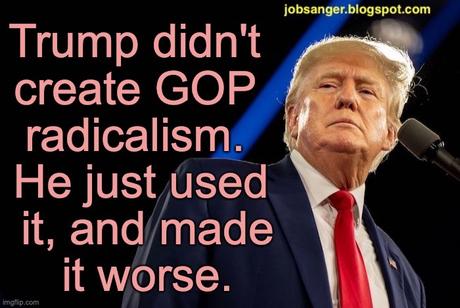
It has become obvious that the Republican Party is no longer a mainstream party. It has become a purveyor of radical extremism. Some would like to blame Donald Trump for this, but it started a couple of decades ago. Trump just recognized the radicalism and used it -- and probably made it a little worse with his thousands of lies.
So, what is responsible for the radicalism of the Republican Party. Perry Bacon, Jr. (in The Washington Post) identifies 5 power centers in the party -- each of which has helped push the party into a radical extremism. Here is part of what he wrote:
To understand, and perhaps even combat, the GOP’s radical turn, it’s important to understand its root causes. I think of the GOP as having five distinct power centers: the party’s voters, elected officials, superwealthy conservative donors, GOP-appointed judges and grass-roots activists.
I have ranked these power centers in order of importance, at least in my view. But the precise order is less important than the general idea that the party’s radicalism is being reinforced at several different levels.
1. Republican elected officials
It’s Republican politicians who pass deeply unpopular laws that roll back individual rights. They break with traditional democratic norms and values, including by spreading the election misinformation that helped lead to Jan 6. They demean institutions and people who try to act in nonpartisan ways, including the FBI, which was viciously attacked by some Republican politicians last week after its search of Trump’s house. And to insulate themselves from accountability from voters, GOP officials aggressively gerrymander legislative districts, particularly at the state level. . . .
2. Superwealthy conservative donors
Wealthy conservatives are a huge reason the Republican Party has moved in an extreme direction. They pump millions into conservative policy groups such as the Federalist Society. They fund media and grass-roots organizations that move voters to the right. They create super PACs that help Trump-aligned conservatives win Republican primaries. And, just as importantly, they often don’t fund organizations or candidates who would move the party back to the center. . . .
3. GOP-appointed judges
Conservative judges, including those on the Supreme Court, usually aren’t executing the most extreme parts of the GOP’s agenda. But through their rulings, these judges enable and at times even encourage it. The aggressive gerrymanders and voter suppression laws adopted by GOP-controlled states over the past decade never would have happened if the Supreme Court had struck down a few of them. They set off a wave of aggressive antiabortion laws by overruling Roe v. Wade.
4. Republican activists and organizations
Republican elected officials don’t come up with their extreme rhetoric and ideas totally on their own. Conservative activists and organizations often write radical proposals and then demand party officials pass them into law. For example, the leading figure in the party pushing for limits on how racism is taught in public schools is Christopher Rufo, a senior fellow at the conservative Manhattan Institute. . . .
5. Republican voters
I don’t want to understate the role of Republican voters in moving the party toward radicalism. Trump, Florida Gov. Ron DeSantis, Rep. Marjorie Taylor Greene (Ga.) and other extremist Republicans would not have power without voters backing them in primaries and general elections. In Wyoming, Republican primary voters could have ignored the views of Trump and other Republican leaders and reelected Cheney, who remains very conservative on most policy issues.
In polls, the clear majority of Republican voters say that Biden didn’t legitimately win the 2020 election, meaning that they either believe the “big lie” or simply aren’t willing to accept that their candidate lost. Despite Jan. 6 and all of the other terrible things he did while in office, and since leaving, Trump is the leading candidate when Republican voters are asked about a potential 2024 primary — numbers that no doubt are part of the reason he might run for president again.
And the Republican voters who oppose Trump-style politicians and back ones such as Cheney in primaries aren’t blameless either. These voters tend to back Trumpian candidates in the general election. Trump himself won more than 90 percent of self-identified Republicans in 2016 and 2020, meaning nearly all of those who opposed him in the 2016 primary eventually fell in line. The Wyoming Republicans who backed Cheney in this week’s primary probably won’t support Democratic candidate Lynnette Grey Bull in the general election. . . .
Because these five groups are reinforcing one another, I see no easy or clear path for the Republican Party to shift toward a George W. Bush-style conservatism (one that embraces multiculturalism and respects core democratic values) anytime soon.

